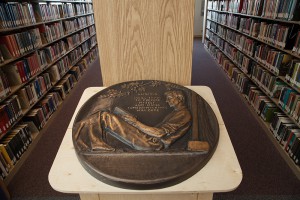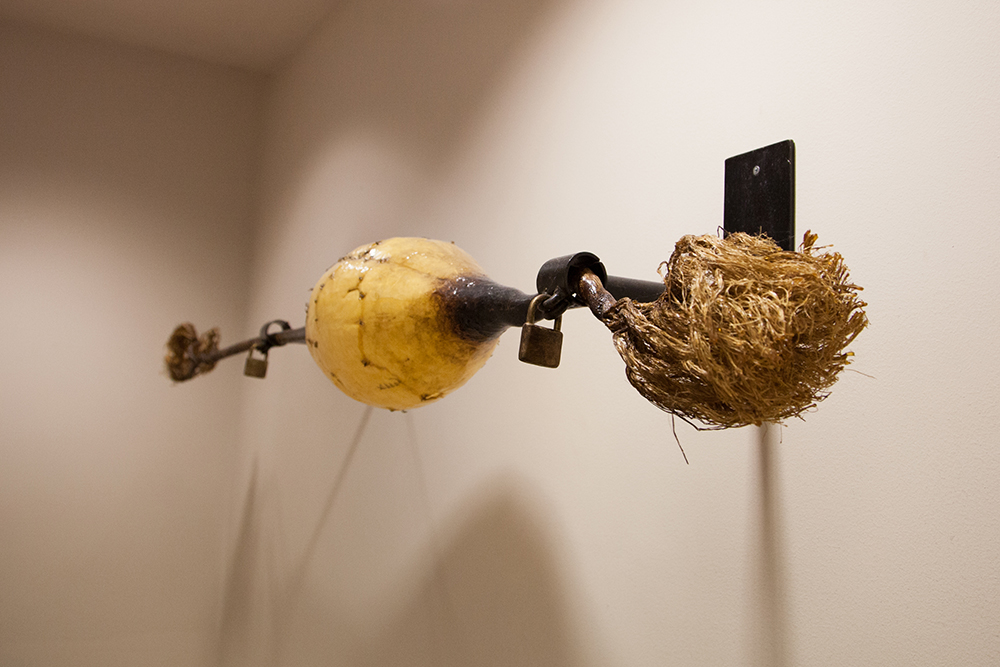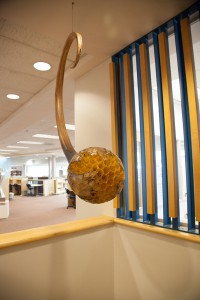Cannell Library provides a fitting home for two artists' legacies
Clark College’s Art Selection Committee recently honored the legacies of two local artists by placing their work in Cannell Library.
In fall 2012, friends of the late Rex Silvernail approached Clark College about receiving one or more of his artworks. Silvernail, an accomplished sculptor, had been diagnosed with Parkinson’s Disease and wanted to ensure that his art would be kept available to the public after his death. Clark is among many institutions that stepped forward to house his work; others include the Portland Art Museum, Hallie Ford Museum, Maryhill Museum, Fort Vancouver Historic Reserve, and the Fort Vancouver Regional Library.
Silvernail was born in Tacoma, Wash. He earned his MFA from Northern Illinois University and later received a Fulbright Scholarship to attend the Kitanmax School of Northwest Coast Indian Art–the first non-Native person to do so–where he learned traditional methods for manipulating wood. He became known for an artistic style that blended contemporary Western techniques with ancient traditions of craftsmanship, creating works that emphasized his interest in environmentalism and world peace.
Silvernail died in April 2013. By then the Art Selection Committee had already begun the process of accepting and placing two of his works: Shilo and Abu Ghraib. The former is a joyous piece made in honor of Silvernail’s granddaughter; the latter has been called “one of his strongest anti-war statements.” Together, they provide a cogent summary of Silvernail’s breadth of subject matter as an artist.
“We chose to place the pieces where they would have maximum visual impact and viewing accessibility,” said Art Selection Committee member and art professor Lisa Conway. “We wanted a space that would enhance the dimensional qualities of these unique pieces, and allow for them to be really set apart from, yet showcased within, their surroundings. After months of considering various sites across our campuses, the committee chose the library location. Cannell Library continues to be a great place to view art on campus.”
The third piece placed in Cannell is a large bronze casting plaque known as “The Lincoln Medallion.” It depicts a young Abraham Lincoln sitting beneath a tree, reading a book, with the inscription “I will study to prepare myself and maybe someday my chance will come.” It was made by George B. Clausen, the father of recently retired business technology professor John Clausen. The younger Clausen, together with his sister, Grace Sorensen, donated the piece to the college in memory of their parents.

Bronze casting plaque of Abraham Lincoln by George B. Clausen, donated by retired business technology professor John Clausen and his sister, Grace Sorensen
George Clausen was, like Lincoln, a self-taught man. He quit high school in order to support his family when his own father became ill, teaching himself the trade of architectural drafting. He also taught himself bronze casting; his works were housed in, among other places, the Oregon State Capitol and the Vista House. In 1937, when he created the mold for the Lincoln Medallion, he was working at the Portland Art Museum.
John Clausen and his sister wanted their father’s medallion to be placed at Clark College–and specifically in Cannell–because of its theme of education and reading.
These three pieces are just the most recent to be sited by the Art Selection Committee, which is responsible for selecting art through the Washington State Arts Commission Art in Public Places Program. This program facilitates the acquisition, placement, and stewardship of artwork in state-funded building projects. One-half of one percent for art funds is generated by new construction projects in state agencies, community colleges, universities, and public schools. Local committees representing project sites make all final artwork selection decisions.
In addition, the Art Selection Committee is responsible for acceptance and location of donated art objects, markers and monuments (other than instruction/gallery items) and the purchase and location of art objects acquired through means other than the Art in Public Places Program. The committee monitors and makes decisions regarding the maintenance and care of all college art objects.
Currently, the college’s art collection includes almost 300 artworks in media as varied as metal sculpture, painting, line drawing, and textiles.














